ENVIRONMENT FRIENDLY PRODUCTS
(Recommended by IND Solutions)
For Ordering Product and/or Donating the Product to NGOs, individuals, villages, towns etc. of your choice, please send us an e-mail on: indsolutions@hotmail.com
(You can contact the producers/distributors directly too. However, if you route your queries through us, we can try to negotiate a better price for you.)
ENERGY EFFICIENT BUILDINGS
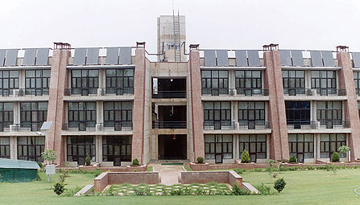 |
 |
|
(Developed by the Energy and Resource Institute, India-http://www.teriin.org/index.php)
RETREAT (Resource-Efficient TERI Retreat for Environmental Awareness and Training) - a self-contained island. The building employs an array of techniques – a ‘combination of modern science and traditional knowledge’ – including solar chimneys and earth air tunnels, fully integrated solar photovoltaic systems, water recycling, and a gasifier that uses firewood, dried leaves and twigs, and similar waste material to achieve not only considerable savings in energy consumption but also to reduce its ‘ecological footprint’. Here are a few more details and highlights of the innovations.
 Solar water heaters Twenty-four solar water-heating panels provide up to 2000 litres of hot (65 °C) water every day. Integrated photovoltaic systems The energy captured by the photovoltaic panels is fed into a battery bank, which is the main source of power at night. A number of panels, each measuring 1.1 by 1.2 metres, are joined and form an integral part of the roof of the building. The panels can generate up to 10.7 kilowatts peak of energy, which is fed into a 900 ampere-hour/240 volt battery bank. Solar water heaters Twenty-four solar water-heating panels provide up to 2000 litres of hot (65 °C) water every day. Integrated photovoltaic systems The energy captured by the photovoltaic panels is fed into a battery bank, which is the main source of power at night. A number of panels, each measuring 1.1 by 1.2 metres, are joined and form an integral part of the roof of the building. The panels can generate up to 10.7 kilowatts peak of energy, which is fed into a 900 ampere-hour/240 volt battery bank.
 Biomass gasifier Firewood, dried leaves and twigs, the stubble left in the field after a crop is harvested, and such other forms of biomass fuel the 50-kilowatt gasifier, which is the source of power for the building during the day. The gasifier runs a generator, the diesel requirements of which have been cut down to 30% after appropriate modifications; the rest of the fuel comes from the gasifier in the form of ‘producer gas’. One unit of electricity produced needs 1 kilogram of biomass and 90 millilitre of diesel. Biomass gasifier Firewood, dried leaves and twigs, the stubble left in the field after a crop is harvested, and such other forms of biomass fuel the 50-kilowatt gasifier, which is the source of power for the building during the day. The gasifier runs a generator, the diesel requirements of which have been cut down to 30% after appropriate modifications; the rest of the fuel comes from the gasifier in the form of ‘producer gas’. One unit of electricity produced needs 1 kilogram of biomass and 90 millilitre of diesel.
|
 Subterranean air tunnels Effective insulation, shade provided by trees, and a network of underground earth air tunnels circulating cool subterranean air throughout the residential block ensure that the temperature in the complex remains more or less even all year round. The system has been augmented by adding chillers for dehumidification and additional cooling during rainy days. Daylighting Specially designed skylights, energy-efficient lights, and a sophisticated system of monitoring and controlling the consumption of electricity illuminate the complex. The conference rooms enjoy glare-free daylight through strategically placed skylights. A master control system switches off the lights automatically whenever it senses that daylight alone is enough to maintain the desired level of illumination. In the living rooms, strategically placed light points and specially designed swivels make it possible to use the light at a study table as well as for bedside reading. Subterranean air tunnels Effective insulation, shade provided by trees, and a network of underground earth air tunnels circulating cool subterranean air throughout the residential block ensure that the temperature in the complex remains more or less even all year round. The system has been augmented by adding chillers for dehumidification and additional cooling during rainy days. Daylighting Specially designed skylights, energy-efficient lights, and a sophisticated system of monitoring and controlling the consumption of electricity illuminate the complex. The conference rooms enjoy glare-free daylight through strategically placed skylights. A master control system switches off the lights automatically whenever it senses that daylight alone is enough to maintain the desired level of illumination. In the living rooms, strategically placed light points and specially designed swivels make it possible to use the light at a study table as well as for bedside reading.
 Recycling waste water A bed of reed plants (Phragmites) clarifies 5000 litres of water from the toilets and kitchen every day; the recycled water is used for irrigation. Sewage is collected initially in a settling tank (an Imhoff tank) that allows sludge to settle to the bottom. Part of the waste is decomposed at this stage by microbes. Then, the water is passed through a bed of soil, which also supports specially selected reeds well adapted to waterlogged soils. The roots of these plants act as living filters: they absorb and remove many of the toxic substances from waste water. Recycling waste water A bed of reed plants (Phragmites) clarifies 5000 litres of water from the toilets and kitchen every day; the recycled water is used for irrigation. Sewage is collected initially in a settling tank (an Imhoff tank) that allows sludge to settle to the bottom. Part of the waste is decomposed at this stage by microbes. Then, the water is passed through a bed of soil, which also supports specially selected reeds well adapted to waterlogged soils. The roots of these plants act as living filters: they absorb and remove many of the toxic substances from waste water.
|
| TRANSPORTATION |
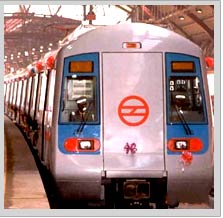 |
DELHI METRORAIL MAKING SIGNIFICANT ENVIRONMENTAL AND SOCIAL IMPACTS IN INDIA'S CAPITAL
If the latest Central Road Research Institute (CRRI) report is any indication, the Delhi Metro, besides making the life of average city traveller smoother and pleasurable, is also making significant environmental and social impacts on country's capital. Ever since its inception, the mass rapid transit system has assisted in:
-
Reduced consumption of petrol, gas, diesel by 57,858 tonnes,
-
40,000 less vehicles on roads
-
improvement in environmental and traffic conditions
-
Saved human lives hitherto lost in traffic accidents
(www.delhimetrorail.com) |
SOLAR ENERGY
|
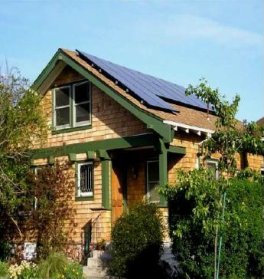
|
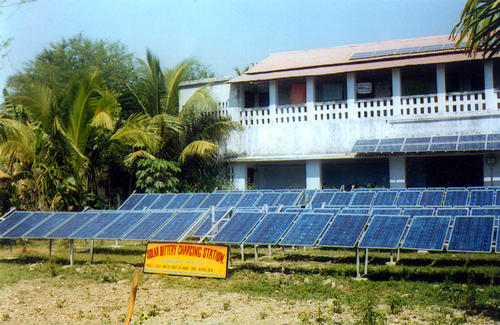
4kW Mid-size Grid-tie Solar PV System Kit
The PV modules have a 25 year warranty and the expected life of the system is about 30-40 years. This system includes the following state of the art equipment: (21) Evergreen 190W PV modules***, roof mounting hardware by UniRac, and a Fronius sine wave grid tie inverter. Note that for best results you need a shade free south to southwest or southeast facing roof. The PV array takes up about 360 sq.ft. (for example, 3, 5’x24’ rows).
|
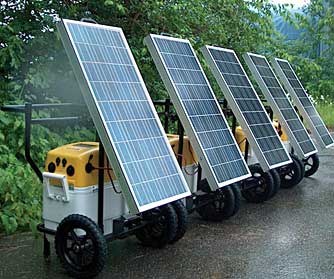 |
Harvester Solar Electric Generator
A quick set-up, nonpolluting, portable solar electric generator ideal for providing power when and where on-grid power sources are not available. Power Center: heavy-duty yellow and white plastic; 20"H x 20"L x 10"W; 70 lbs. with 105 Ah battery. Solar Module: 80W; 17V; 4.7A; 473/10"H x 212/5"L x 14/5"W; 21 lbs. Charge controller: 15A PWM with LCD display and electronic overcurrent protection. 10-year limited warranty for solar panel, six-month warranty for battery, five-year warranty for controller. USA. |
WIND ENERGY
|
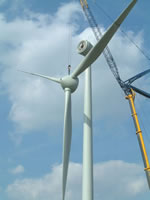
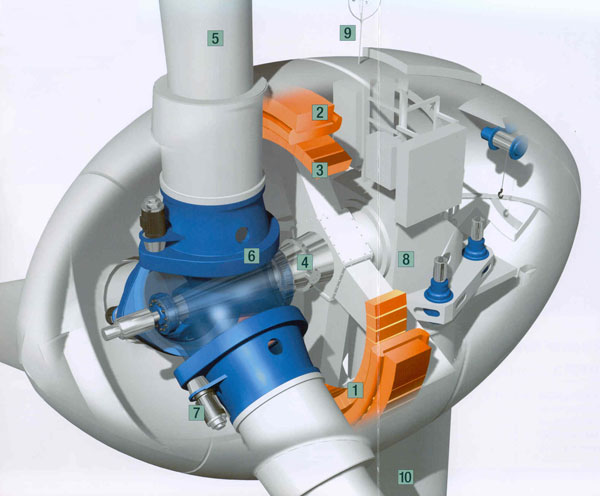
|
One of the two 85m high turbines powering Ford's new Dagenham Diesel Centre
Building new wind capacity is crucial in the fight against climate change
Ecotricity is building new turbines to make clean electricity to replace the conventional polluting sources that cause climate change. Every unit of green electricity from wind power replaces one unit of electricity normally generated from conventional polluting sources such as coal.
Wind is a sustainable fuel source that doesn't produce pollutants of any kind and its energy can be harnessed without causing any damage to the environment. The energy used in manufacturing and erecting a wind turbine is paid back in the first 3 to 6 months of operation. At the end of a wind turbine's lifetime, typically 30 years, it can be removed, leaving behind no lasting legacy. Please visit Ecotricity website for more information: http://www.ecotricity.co.uk/ |
WASTE DISPOSAL
|

|
BigBelly ® Cordless Compaction System
The solution to your waste management challenge
♦ Solar-powered, automatic compaction
♦ Reduces collections by 4 times or more
♦ Eliminates overflowing bins
♦ Keeps litter in, pests out
♦ No trenching or wiring needed
♦ Reliable, safe and easy to use
♦ Demonstrates commitment to community
& environment
♦ Ad mounts provide marketing platform |
ENERGY CONSERVATION
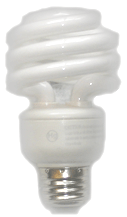 |
CFL BULBS - A GREAT WAY TO SAVE ENERGY
There’s good reason entire countries have begun to contemplate outlawing the incandescent bulb. About 90% of the energy required to light an incandescent bulb is completely wasted as heat! The incandescent bulb is, in many ways, a technological relic from the age of Thomas Edison (circa 1880!).
CFL bulbs offer a great solution that is available today. CFLs use about 75% less energy than incandescent lights for the same light output. Overall, CFLs are one of the easiest and most effective ways to reduce energy use in your home. CFL bulbs also last up to 10 times longer than incandescent bulbs. In the lifespan of one CFL, you could end up changing 10 incandescent lights. That means 9 fewer trips to the store and 9 fewer climbs up onto a chair to replace bulbs in hard-to-reach overhead fixtures. |
 |
SOLAR RECHARGEABLE LANTERN
These rugged and attractive solar powered lanterns have a 9W U-shaped "Energy Saving" fluorescent tube with blinking signal light.
The SL9000M features portable carrying handle, solar panels, 3-way diamond cut reflectors make for a brilliant light output and right orange emergency flashers. The SL9000M solar lantern also comes standard with 3 ways to charge. The folding solar panel, an auto adaptor, and a UL listed house adaptor. With the built-in emergency feature, leaving the light plugged into the house current in the on position, if there is a power failure, the light automatically turns on. The SL9000M solar rechargeable lantern is ideal for camping, boating or outdoor use in remote areas. The SL9000M has a motion activated feature so the light can be switched so it will automatically come on when camping or when activated in darkness. |
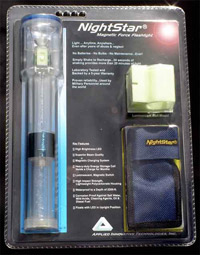 |
|
MAGNETIC FORCE FLASHLIGHT
This flashlight has no parts to burn out, break, or replace. A sustainable light source that requires a small amount of shaking to charge the gold-film capacitor. Because it does not have a battery it will operate in extreme temperatures and does not produce any waste. The T1 diode (LED) is the brightest in the world and has a rated lifetime of more than 50,000 hours.
Light output: 720 ft-candles at maximum charge. Operational from -40F to 130F, works to depths of 2110 feet and is corrosion resistant.
A strong magnetic field surrounds Nightstar flashlights, do not set within 16" of computers, monitors, televisions, or magnetic information storage devices.
Please use caution when using any magentic device close to pacemakers. |
|
|
|
|
|
| |
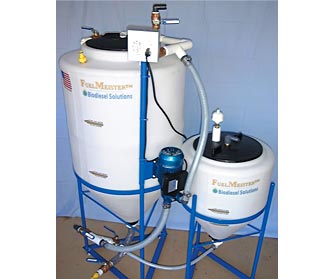 |
BIODIESEL PROCESSOR
With a biodiesel processor, you don't have to be a plumber or mechanic to make your own biodiesel. This is not a hobby kit but a complete system engineered with quality materials. You get all the specialized equipment and supplies you need to start making biodiesel that same day. All you need to add is vegetable oil, methanol, electricity, and tap water. The whole setup fits comfortably in the corner of your garage. This is a "closed" system, so it won’t smell, and you won't have to pour or stir any liquids. It will turn even heavily used cooking oil into clean burning, biodegradable, and smooth-running biodiesel. Whatever you own that runs on diesel fuel you can power with the biodiesel you produce with your own biodiesel production system.
It produces approximately 40 gallons of biodiesel every 48 hours, with about one hour of operator time required per batch. Supplies typically cost 70 cents per gallon or less. |
GREEN BUILDING ENERGY MODELING AND SOFTWARE TOOLS
Building energy modeling is an efficient and effective way to determine which combination of strategies and equipment is the best fit for a particular project. These computer programs allow 'green building professionals' to model a variety of energy consuming systems and scenarios and compare the energy loads and costs to optimize the energy efficiency of the building.
|
|


|
US DOE - EnergyPlus
EnergyPlus models heating, cooling, lighting, ventilating, and other energy flows as well as water in buildings. While originally based on the most popular features and capabilities of BLAST and DOE-2, EnergyPlus includes many innovative simulation capabilities such as time steps of less than an hour, modular systems and plant integrated with heat balance-based zone simulation, multizone air flow, thermal comfort, water use, natural ventilation, and photovoltaic systems. (Source: US Department of Energy) |
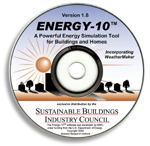 |
Powerful Energy Simulation Tool
for Buildings and Homes
ENERGY-10™ software analyzes and illustrates the energy and cost savings that can be achieved by applying up to a dozen sustainable design strategies. Hourly energy simulations quantify, assess, and clearly depict the benefits of:
-
Daylighting
-
Passive solar heating and cooling
-
Natural ventilation
-
Well-insulated building envelopes
-
High-performance windows
-
High-performance lighting systems
-
High-performance mechanical equipment
-
And more (http://www.gvrd.bc.ca) |
|

(Source: Natural Resource, Canada) |
RETScreen Version 4: Energy Efficiency & Renewable Energy
In RETScreen Version 4, the software's capabilities have been expanded from renewable energy, cogeneration and district energy, to include a full array of financially viable clean power, heating and cooling technologies, and energy efficiency measures.
- Development of a suite of new models to evaluate energy efficiency measures for residential, commercial and institutional buildings; communities; and industrial facilities and processes.
- Expansion of the RETScreen Climate Database to 4,700 ground-station locations around the globe and incorporation of the improved NASA Surface Meteorology and Solar Energy Dataset for populated areas, directly into the RETScreen software.
- Translation of the integrated single software file and databases into 21 languages (e.g. Chinese, French, German, Hindi, Italian, Japanese, Portuguese, Russian, Spanish, etc.).
|
  |
 |
| The desire to mitigate environmental impacts has provided a driver for the ‘green infrastructure' movement in British Columbia. This movement is water-centric, is founded on a natural systems approach, and is influencing infrastructure policies, practices and standards. The Water Balance Model Partners Forum hosted by the Greater Vancouver Regional District in March 2007 provided a timely opportunity to roll out Beyond the Guidebook, the runoff-based approach to drainage modeling that underpins the Water Balance Model powered by QUALHYMO. |
 |
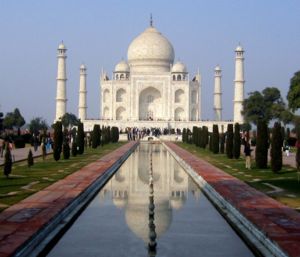
(Source: Sunil Kataria, Reuters) |
TAJ MAHAL - THE DARKER SIDE
The Taj Mahal is ill and could be slowly dying.
India's most famous monument, which is in the running to be voted as one of the seven new Wonders of the World, flanks a stinking, garbage-infested river and is almost always enveloped by dust and smog from belching smokestacks and vehicles.
Millions of Indians hope the majestic white marble mausoleum, which took 17 years and 20,000 workers to build, will feature on the Wonders list, but conservationists and environmentalists are urging people to pay attention to its darker side.
"If things continue like this, the Taj Mahal's age will decrease, like that of a diseased man," said KS Rana, a leading campaigner for saving the Taj, located in Agra, a four-hour drive from New Delhi. |
|

GOLDEN TEMPLE SETS AN EXAMPLE IN ENVIRONMENT
The community kitchen in the Golden Temple complex, the holiest of holy Sikh shrines at Amritsar, uses solar energy for its community kitchen says a report in the Indian Express. The Union Ministry of Non-Conventional Energy has asked the Punjab Energy Development Agency (PEDA) to prepare a detailed project report for the purpose. |
The solar cooking system, set-up at a cost of Rs.1 crore has the capacity to cook for 30,000 persons everyday, the biggest of its kind in the country.
On any given day, hundreds of people eat the langar at the Golden Temple complex and the number multiplies during festivals.
Earlier, the langar was cooked using gas and wood as fuel. According to PEDA executive director Jagjit Puri, the project involves the use of German technology. The solar panels have been installed on the roofs of big buildings in the complex, including Teja Singh Samundari Hall and Guru Nanak Niwas and other serai's. Solar energy is transmitted to the main kitchen from these panels. The panels has been mounted on a rotor to face the sun.
The Golden Temple complex langar serves food to about 1,000 persons at a time and is closed late at night | |